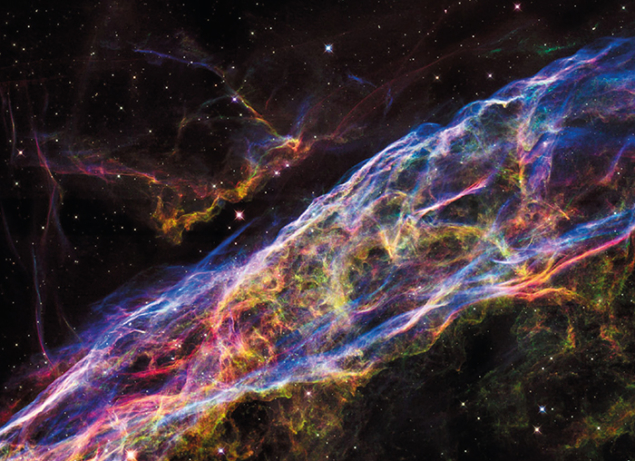
Image credit: NASA, ESA, Hubble Heritage Team.
The observed spectrum of cosmic rays has several puzzling features. For instance, the Alpha Magnetic Spectrometer (AMS) measured an excess of positrons and antiprotons at around 100 GeV. While it is tantalising to interpret such discrepancies as dark-matter signatures, a new study shows that they could simply be due to the injection of cosmic rays by a nearby supernova, which exploded two-million years ago.
The composition and spectral properties of cosmic rays are studied with unprecedented accuracy by the AMS-02 experiment (CERN Courier October 2013 p23). Mounted on the International Space Station since May 2011, it has already detected and characterised close to 100 thousand million cosmic rays from outer space. This wealth of data constrains extremely precisely the spectral properties of electrons, positrons, protons and antiprotons, as well as of helium and heavier nuclei.
Rather than disproving earlier results by the Payload for Antimatter Matter Exploration and Light nuclei Astrophysics (PAMELA) (CERN Courier September 2011 p34), the AMS measurements confirm several cosmic-ray “anomalies”. Indeed, the observations do not follow the expected trend for galactic cosmic rays. The main differences are a softer spectral slope of protons as compared with heavier nuclei in the TeV–PeV energy range, and an excess of positrons and antiprotons above ~30 GeV.
According to a small group of astrophysicists, these puzzling discrepancies could simply be due to an additional source of cosmic rays from a nearby supernova. Led by Michael Kachelrieß from the Norwegian University of Science and Technology in Trondheim, the team demonstrates in a recent paper that this is a valid explanation. The researchers get a good match with the observations for a source injecting ~1043 J in cosmic rays with energies up to at least 30 TeV. The researchers derive this by using a code that follows the trajectories of individual cosmic rays through the galactic magnetic field (GMF) after an instantaneous injection.
They further obtain that the supernova should have been roughly aligned with the local GMF direction at a distance of several-hundred light-years and must have exploded about two-million years ago. A rough estimate based on the size of the Milky Way and the rate of about two supernovas per century (CERN Courier January/February 2006 p10), shows that there is a good chance that one has indeed exploded at the inferred distance from the Sun during the last few-million years. Interestingly, independent evidence for such a nearby supernova explosion was already derived from a deposition of the iron isotope 60Fe in a million-year-old layer of the ocean crust.
The authors suggest further possible tests of the nearby supernova interpretation, such as the measure of the Beryllium isotopic ratio 10Be/9Be, because 10Be has a radioactive lifetime of about one-million years. If the idea withstands further data from AMS-02, this would rule out the hopes that the cosmic ray “anomalies” would be a signature of something more fundamental, like dark-matter annihilation or decay.








